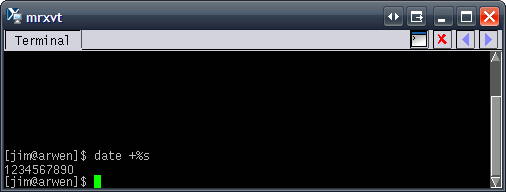A Special Day for Geeksby Jim
13 Feb 2009
11:02 am2
You’ll have to pardon my geekiness, but today is a very special day. Today, at 3:31:30 pm Pacific (11:31:30 pm UTC), Unix Epoch time will reach 1,234,567,890. It is kind of like celebrating January 1st in the year 1000, at the turn of the millennium. So that you can more fully appreciate this special moment, let me give a brief history lesson.
You see, way back in the early days of computing (1969), some really smart guys at AT&T Bell Labs developed Unix. Unix is an operating system (like unto Windows) that runs programs except it didn’t have a graphical user interface (GUI with mouse pointers, icons, etc. — unlike unto Windows). A GUI was developed later, but at first it was all just command line stuff. For geeks, this is one of the things that makes Unix fun. Anyway, they needed a way to represent time, so they decided to use a standard integer value counting in seconds. Therefore, at 12:00:01 AM January 1st, 1970 Unix time started at 1 and they’ve been counting ever since.
Back on Sept. 9, 2001, Unix time rolled around to the 1 billionth second since Unix Epoch (1 Jan, 1970). The geeks over in Denmark thought this was pretty cool, so they threw a big party. Those Europeans are really into the whole Unix/Linux thing. Actually, I think it is more likely they are into the Anti-Microsoft thing.
So, if you read this before the big event, set your alarms and have a moment of reflection for how Unix makes the world a better place.

(This image was modified for demonstrative purposes.)
For those of you who want to witness this event, find your nearest Unix/Linux machine and type:
date +%s
If you don’t think you’re fast enough to get it on just the right second, you can try:
watch -n 1 date +%s
Which will display once a second, so you’re sure to catch it.
It’s a keeper!by Jim
30 Sep 2008
6:09 pm2

The long search is over. I’ve finally decided on my official Linux server distro: ArchLinux. I’ve spent the last few weeks (and many, many hours) trying out a few different distros and have found the one I want to stick with. Recently, I installed a trial copy of Windows Home Server after hearing a few recommendations. This meant that my Linux server (where this blog is hosted, among other sites) would have to make room for another OS. I don’t think I could survive without a Linux server, though, so I chose to take the virtualization route. I tried out a few different virtual server programs and found Microsoft’s Virtual Server the most useful. I wanted to use Sun’s VirtualBox, but Microsoft’s product has a web interface for configuring and controlling your servers: very cool. Besides, it also automatically starts up as a service, just like it should.
Anyway, I would have used the same distro I had on the machine before installing Windows Home Server, but my version of Ubuntu didn’t seem to like being virtualized and it would freeze nearly every morning. I got tired of reseting it, so I started looking for more distros. I tried Fedora: too bloated — especially for a virtual server. I tried Debian, but it didn’t like living in a virtual environment either; it couldn’t get anything from the repositories. Then I found Arch (thanks to Antony). It was just what I wanted: robust, but simple. Simple meaning complexity, not ease of use. Arch is not for the faint-hearted. I consider myself a fairly experienced Linux user, so I gave it a whirl. As you can see, Arch doesn’t have the freezing problems Ubuntu had. I’m glad I finally found something that works well. Arch is here to stay.
